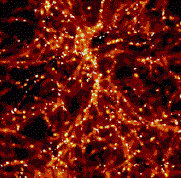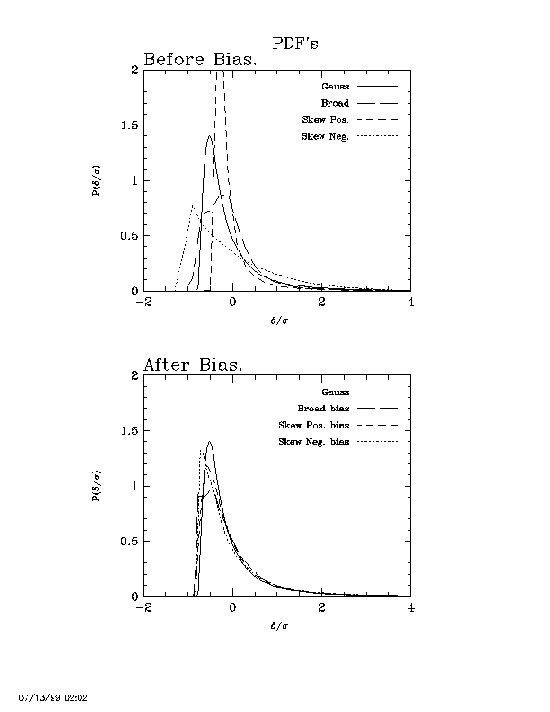Biased Galaxy Formation
 Biased
Galaxy formation may emerge naturally in a standard Cold Dark Matter model
.
Biased
Galaxy formation may emerge naturally in a standard Cold Dark Matter model
.
To see this one can consider two collapsing galaxies, one of which is located
in a relatively underdense background region while the the other is located
in a overdense background region. Naturally the galaxy in the overdense
region will collapse quicker and and its core will become dense enough
to efficently cool and form stars. Although the galaxy in the
underdense region will also collapse given enough time, it is quite
possible that it will never reach high enough density in order to radiatively
cool down and form star s and hence become visible. In this sense
one would tend to expect a stronger bias of galaxy scale peaks
in regions of high background densities. However, it is important
to realize , especially in the context of this project, that a simple biasing
scheme based on gaussian statistics may not apply to non-gaussian models
. In any case in this section we describe our exact prescription for biasing
the non-gaussian models in an effort to mask the observable differences
to the gaussian model.
Our Biasing Scheme
We'd like to
adopt an ad hoc biasing scheme for our non-gaussian models (skew-positive,
skew-negative, broad) which will try to reconcile the resultant differences
in observable structure when compared to the gaussian model.
The Scheme:
Apply a bias such that the resultant Probability Distribution Function
(PDF) of the
non-gaussian model will want to match the resultant PDF
of the gaussian model.
PR
(d)= probability
of finding a galaxy density constrast d
after smoothing with
characteristic scale R . (R=3
h-1 Mpc for all our analysis).
Steps Involved With Bias Matching:
-
Smooth resultant simulation outputs
from both the gaussian and non-gaussian models
-
Rank the cells in each each simulation
box in order of decreasing density
-
For each cell of the same rank as as
the gaussian model apply the following probability for selection of the
particle as a galaxy:
Psel=Ngauss_galaxies/Nnon-gauss_particles
-This biased selection effect is very effective
since galaxies are only selected if they
tend to want to make the resultant
PDF more similar to gaussian PDF at z=0.
-This scheme is especially attractive since it preserves
two important features of gaussianity:
LOCALITY: rho_gal=F(rho_mass)
-> (galaxy density is dependent on local mass
density)
MONOTONIC: If rho_mass(x1)>rho_mass(x2)
then rho_gal(x1)>rho_gal(x2)
This will essentially give our non-gaussian model its
best chance to mimic guassian characteristics.
One thing worth looking at right from the start is whether
the biasing actually makes the non-gaussian
PDF want to match the gaussian PDF...
Does it work?

As we can see the biasing does indeed do what we
want it to do...
now the question which comes up is :
Will this bias be able to mask
all forms of non-gaussianity which would have previously been easily
identified?
(Go on to Part III to find out)
-<Aaron Sokasian>

 Biased
Galaxy formation may emerge naturally in a standard Cold Dark Matter model
.
Biased
Galaxy formation may emerge naturally in a standard Cold Dark Matter model
.
